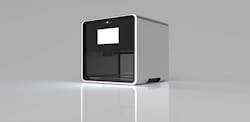It’s Friday night and you want a pizza, but instead of calling the local pizzeria for delivery, you just print out your dinner. Think that sounds a bit too farfetched? Think again.
Foodini from Natural Machines is a 3D printing kitchen appliance that makes pizza, pasta, breads and cookies. It assembles layers of fresh ingredients to take a complex process, like making ravioli, and simplifies the steps, as well as easing the kitchen clean up which is a big value-add.
Initially targeting professional chefs, Natural Machines’ co-founder Lynette Kucsma envisions a time in the near future when a 3D food printer will be a common kitchen appliance. Foodini, which is currently available in limited production with general availability in 2016, will cost about $1,500, according to the Natural Machines website. And, as competitors hit the market and prices start to plummet, a 3D printer could be a convenient way for consumers to make healthy meals on-the-go rather than turning to highly-processed foods packaged for the microwave.
It could also represent a significant shift in the way food is manufactured.
According to a recent Fortune magazine article, Kucsma is talking with food manufacturers who are inquiring about how this will impact their market. Meanwhile, the confection companies are already onboard with their own 3D printer products.
The Hershey Company unveiled its CocoJet 3D printer made by 3D Systems, last December. Using an iPad pre-loaded with a library of 3D graphics, consumers can print out a chocolate kiss with a laced pattern, for example. Or, upload their own design to personalize the print out.
It’s interesting and entertaining, but right now it’s not very practical as it takes about an hour to make one chocolate kiss. But, as with any technology, it will evolve to be faster, more sophisticated, and most likely integrated with other systems. When that happens, a whole new manufacturing model will emerge.
Imagine the ability to support mass personalization at micro manufacturing facilities around the world.
Industry experts say 3D printing will help food manufacturers reduce costs and save production time. As reported by Food Manufacture (foodmanufacture.co.uk), 3D manufacturing technology could become a fundamental part of the food and beverage supply chain as early as the end of this decade, enabling local production, material savings and customization.
A consumer with a 3D food printer at home could log into an online database of recipes, for example, and as long as there’s a cartridge with the right ingredients in the printer, they could whip up a personal meal.
Think of the applications. The U.S. military is researching 3D food printing on the battlefield, Mary Scerra, a food technologist at the U.S. Army Natick Soldier Systems Center, told attendees at an Institute of Food Technologists (IFT) symposium this past summer. She said that by 2025 or 2030, the military envisions using 3D printing to customize palatable, nutrient-rich meals for soldiers.
“Imagine warfighters in remote areas—one has muscle fatigue, one has been awake for a long period without rest, one lacks calories, one needs electrolytes, and one just wants a pizza,” Scerra said. “Wouldn’t it be interesting if they could just print and eat?”
Not only could 3D printing speed up production and delivery of food to people in all parts of the world, but it could also play a role in the need for sustainability in the food chain. By the year 2050, we will need to feed 9 billion people. The issue is not only growing and producing enough food, but also getting it to people in all corners of the world who need it.
While not something I thought too much about until recently, I do see a day when 3D food printers will revolutionize the food industry. Forget from farm to fork, now we’re talking from tablet to table.
Leaders relevant to this article:

